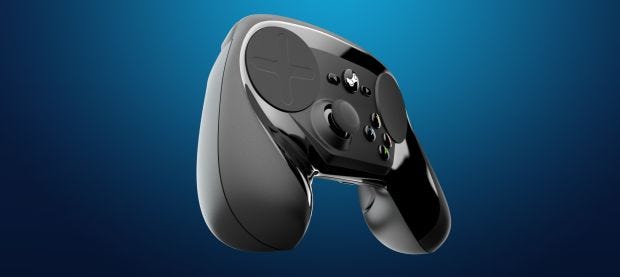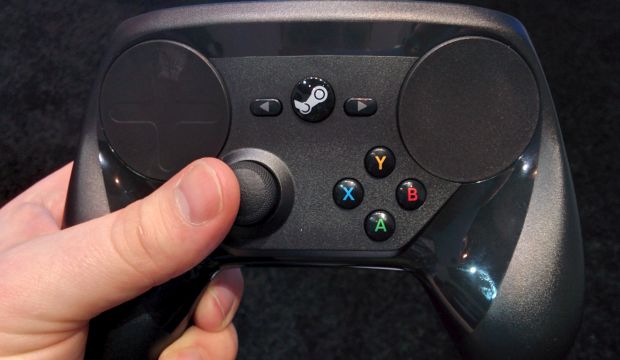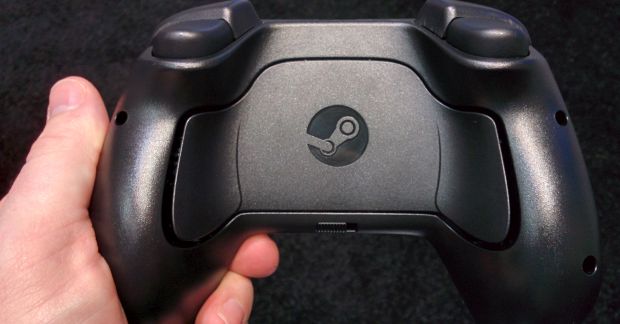Hands On With Valve's Hardware Bonanza
Full Steam Ahead (I'm Fired)
Sitting down with Valve's Eric Johnson this morning, one thing seemed to become increasingly clear. Valve, a studio that has arguably been pretty quiet of late (not least with the failure to ship Steam Machines in 2014), is coming to life again. With a slew of announcements at this year's GDC, the HTC-tech-incorporating VR Vive, a proper announcement of Source 2, in-home streaming tech in Link, available builds of Steam OS, and a final build for their much anticipated controller, you could almost forget that none of them is a game. While Graham was being pulled into a virtual world, I had a play with the controller on games running on a couple of Steam Machines, on some rather enormous televisions.
So the first thing you want to know: is the controller any good?
At first, I worried. I was handed it to play Talos Principle running on a mid-spec Steam Machine, via Steam OS, and my initial thought was: "Ooh, they're close." And then I asked if I could adjust the sensitivity.
It was immediately interesting to see that Steam OS overrode the game's own input settings. Valve called up the controller's settings, a lovely clean layout, dropdown menus alongside the buttons on a crisp illustration of the controller. On the controller, my right thumb sat on what's essentially a clickable trackpad, and the sensitivity of this mouse-substitute was slightly boosted. Back into the game, and my mind changed. "Ooh, they've done it."
With the addition of an analogue thumbstick on the left side, below what still looks like a slightly clumsy circular d-pad, I didn't have to think about using it to move around. That seems really important. As someone who's pretty familiar with a 360 pad, I still have moments of disconnect when trying to emulate proper good-old-fashioned mouse/keyboard interaction. Here I didn't have to pause, or look down, or get used to it. It just sort of felt right.
Well, right-ish. What's interesting about all of Valve's efforts is that they're doomed to never make anything that matches a mouse and a keyboard. The very best they can hope for is to get close. It's about plotting a point on the line drawn between a classic console controller, and the office machinery that so mysteriously best suits our gaming needs. From a brief play, I'm not confident to plot that point, but I'm pretty sure it's closer to a mouse than you might expect.
Another feature that is packed with potential are the analogue triggers. Laid out as you might expect, placed below traditional shoulder buttons, the triggers can detect use long before they reach a final click. The theory being that developers and players can use this imaginatively. Maybe have a squeeze bring up your ironsights, and a click fire. As Valve point out, this would free up fingers to do more at the same time.
They've also had the rather common sense idea to put yet another pair of buttons set into the underneath of the casing, where your ring fingers naturally rest. Which leads to the realisation that ring fingers have been lazily doing nothing for too long - again it's instinctive, and just felt right. In fact, it feels damned weird it's not the norm.
I was also shown Link, their in-home streaming box. Which is tiny! A little baby! It's a device that'll stream your gaming machine to any other screen in the house. It's Apple TV, but for games. Maybe. And compared to the wheezing old Frankensteinian hulk of a PC that's currently next to my living room TV, it could be quite the upgrade.
Streaming, of course, comes with concerns about lag. Nvidia's peculiar announcement of yet another piece of tech called Shield this week boasted that their OnLive equivalent, Grid, would "only" have a latency of 150ms. Something most gamers couldn't cope with. While Link is of course only moving a game through the mystical ether within the same house, you may have similar worries. From our first glance, you may be able to let them go. Shadows Of Mordor played so smoothly, again on a Steam Controller, that we completely forgot it wasn't being directly played. Now, let's be clear - this was in Valve's own setup, in what are presumably their ideal conditions. It'll be important to find out, they say this November, how it performs in an actual real-life house. It sure is cute though.
All of these games were being shown off on TV screens the size of a wall. Astonishingly top-of-the-range televisions, maybe 100", and looking stunning. These were quite comically described as the sorts of screens people will now be getting in their living rooms. I would dearly love a living room big enough to fit in one of those screens. But their point being, Steam OS was able to take advantage of them. Talos was being played at 120FPS on a 120Hz TV. Now, I'm not one of these savants who can detect framerates with my robot eyes, but it sure looked purty.
When we were shown Counter-Strike: GO on a top-end Steam Machine, in this case a Falcon Northwest PC costing well in excess of $2000 (they weren't quite sure, it was somewhere between $2000 and $5000), it was on a 4K TV running at 60FPS. And it's worth noting that all Steam Machines will come equipped with the same capabilities as a Link box, letting you get a low-end Steam box but still stream from your screeching beast upstairs.
A big part of this move toward Steam OS and its Linux architecture has been Valve working in collaboration with many big names in the industry, notably with the exception of Microsoft, on developing this new version of OpenGL. Freeing gaming of DirectX is not a goal Valve is willing to say they're part of, but it's obviously a big dent in Windows' grip on PC gaming to see OpenGL so significantly revived. Linux, Valve says, consistently gets better performance out of games than Windows, and obviously the free and open nature of Linux suits their interests.
And it's worth noting that Valve seem pretty determined not to let sofa-based gaming mean a step away from modding and the like. While you'll obviously be making the mods on a proper grown up machine in a proper grown up hovel, accessing them is something they have built into Steam OS, showed off for CS:GO, in nice, tiled desktop that looked like someone had given the PS4 interface a nice spring clean.
Once again, we were seeing all these things in Valve's set-up, so it's important to wait and see how it all comes together in a regular lounge in a regular house on some regular internet. But after a very disappointing 2014 in which Valve significantly failed to deliver, 2015 is looking far more promising. The controller has come together - it felt great in my hands, and while it cannot be a substitute for a mouse and keyboard, it's a league better than trying to play an FPS with a clunky old console controller. I've got a strong feeling it's going to be a peripheral that'll become ubiquitous amongst PC users. As a regular user of a 360 controller for PC gaming, I'm already certain I'll be upgrading to it, despite my lack of a burning need for gaming from a couch. As for Steam Machines... it's a tougher sell for me. Clearly there's going to be a good range of tech and prices, but I need more convincing that a Linux OS is going to be a computing home. With a commitment to release this all this November, I'm looking forward to seeing if I can be sold on the idea.















